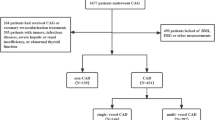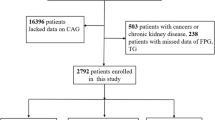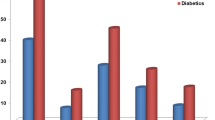Abstract
Type 2 diabetes mellitus is a risk factor for coronary artery disease (CAD). While there is a clear association of fasting plasma glucose (FPG) with microvascular complications, the risk for CAD conferred by FPG is relatively less clear. Therefore, we investigate the association between different FPG and the prevalence and severity of angiographic CAD in high-risk Chinese patients without known diabetes. Among 1,419 subjects who were to undergo coronary angiography for the confirmation of suspected myocardial ischemia, 906 subjects without known diabetes were included in this study and categorized into four groups according to the level of FPG: group 1, ≤5.5 mmol/l; group 2, 5.6–6.0 mmol/l; group 3, 6.1–6.9 mmol/l; and group 4, ≥7.0 mmol/l. Significant angiographic CAD was defined as ≥50 % lumen diameter reduction in at least one major coronary artery in a given subject. The severity and extent of coronary atherosclerosis were defined as the number of diseased vessels, the proportion of totally occluded vessel and the Gensini score. Associations between FPG and the prevalence and severity of CAD were assessed by logistic and linear stepwise regression analyses. The angiographic CAD prevalence, the number of diseased vessels, the totally occluded vessel, and the Gensini score increased corresponding to increasing FPG levels from ≤5.5 mmol/l to 5.6–6.0 mmol/l to 6.1–6.9 mmol/l to ≥7.0 mmol/l (P < 0.05). The FPG had significant association with angiographic CAD (adjusted OR, 1.53; 95 % CI, 1.19–1.98; P = 0.001) and the Gensini score (standardized regression coefficient = 0.172, P = 0.011). Compared with group 1, group 2, 3 and 4 demonstrated significantly higher CAD prevalence after adjustment (adjusted OR, 1.61 [1.16–2.19]; P = 0.015 for group 2; 1.49 [1.11–2.59]; P = 0.027 for group 3; and 4.19 [2.85–6.16]; P = 0.024 for group 4, respectively). FPG group was also significantly associated with the Gensini score (Standardized coefficients, 0.185; P = 0.007, respectively). FPG was an independent risk factor for the prevalence and severity of significant angiographic CAD in our study population. The severity of angiographic CAD increased along with the increasing FPG levels even in prediabetic state.

Similar content being viewed by others
References
Kannel WB, McGee DL (1979) Diabetes and cardiovascular disease. The Framingham study. JAMA 241(19):2035–2038
Stamler J, Vaccaro O, Neaton JD, Wentworth D (1993) Diabetes, other risk factors, and 12-yr cardiovascular mortality for men screened in the multiple risk factor intervention trial. Diabetes Care 16(2):434–444
Gabir MM, Hanson RL, Dabelea D, Imperatore G, Roumain J, Bennett PH, Knowler WC (2000) Plasma glucose and prediction of microvascular disease and mortality: evaluation of 1997 American Diabetes Association and 1999 World Health Organization criteria for diagnosis of diabetes. Diabetes Care 23(8):1113–1118
Davidson MB (2002) Counterpoint: the oral glucose tolerance test is superfluous. Diabetes Care 25(10):1883–1885
Genuth S, Alberti KG, Bennett P, Buse J, Defronzo R, Kahn R, Kitzmiller J, Knowler WC, Lebovitz H, Lernmark A, Nathan D, Palmer J, Rizza R, Saudek C, Shaw J, Steffes M, Stern M, Tuomilehto J, Expert Committee on the Diagnosis and Classification of Diabetes Mellitus (2003) Follow-up report on the diagnosis of diabetes mellitus. Diabetes Care 26(11):3160–3167
The Diabetes Control and Complications Trial/Epidemiology of Diabetes Interventions and Complications Research Group (2000) Retinopathy and nephropathy in patients with type 1 diabetes four years after a trial of intensive therapy. N Engl J Med 342(6):381–389
The Diabetes Control and Complications Trial Research Group (1993) The effect of intensive treatment of diabetes on the development and progression of long-term complications in insulin-dependent diabetes mellitus. N Engl J Med 329(14):977–986
Gu D, Reynolds K, Duan X, Xin X, Chen J, Wu X, Mo J, Whelton PK, InterASIA Collaborative Group (2003) Prevalence of diabetes and impaired fasting glucose in the Chinese adult population: International Collaborative Study of Cardiovascular Disease in Asia (InterASIA). Diabetologia 46(9):1190–1198
Farhan S, Jarai R, Tentzeris I, Kautzky-Willer A, Samaha E, Smetana P, Jakl-Kotauschek G, Wojta J, Huber K (2012) Comparison of HbA1c and oral glucose tolerance test for diagnosis of diabetes in patients with coronary artery disease. Clin Res Cardiol [Epub ahead of print]
Schinner S, Füth R, Kempf K, Martin S, Willenberg HS, Schott M, Dinh W, Scherbaum WA, Lankisch M (2011) A progressive increase in cardiovascular risk assessed by coronary angiography in non-diabetic patients at sub-diabetic glucose levels. Cardiovasc Diabetol 10:56
Berry C, Noble S, Grégoire JC, Ibrahim R, Levesquie S, Lavoie MA, L’Allier PL, Tardif JC (2010) Glycaemic status influences the nature and severity of coronary artery disease. Diabetologia 53(4):652–658
Alberti KG, Zimmet PZ (1998) Definition, diagnosis and classification of diabetes mellitus and its complications. Part 1: diagnosis and classification of diabetes mellitus provisional report of a WHO consultation. Diabet Med 15(7):539–553
Alpert JS, Thygesen K, Antman E, Bassand JP (2000) Myocardial infarction redefined—a consensus document of The Joint European Society of Cardiology/American College of Cardiology Committee for the redefinition of myocardial infarction. J Am Coll Cardiol 36(3):959–969
Joint European Society of Cardiology/American College of Cardiology Committee (2000) Myocardial infarction redefined—a consensus document of the joint European Society of Cardiology/American College of Cardiology Committee for the redefinition of myocardial infarction. Eur Heart J 21(18):1502–1513
Friedewald WT, Levy RI, Fredrickson DS (1972) Estimation of the concentration of low-density lipoprotein cholesterol in plasma, without use of the preparative ultracentrifuge. Clin Chem 18:499–502
Fievet C, Nuttens MC, Ducimetiere P, Fruchart JC, Bertrand M, Salomez JL (1991) Relation of arteriographically defined coronary artery disease to serum lipoprotein particles mapped with monoclonal antibodies. Circulation 84(1):153–159
Gensini GG (1983) A more meaningful scoring system for determining the severity of coronary heart disease. Am J Cardiol 51(3):606
Su G, Mi S, Tao H, Li Z, Yang H, Zheng H, Zhou Y, Ma C (2011) Association of glycemic variability and the presence and severity of coronary artery disease in patients with type 2 diabetes. Cardiovasc Diabetol 10:19
Anand SS, Dagenais GR, Mohan V, Diaz R, Probstfield J, Freeman R, Shaw J, Lanas F, Avezum A, Budaj A, Jung H, Desai D, Bosch J, Yusuf S, Gerstein HC (2011) Glucose levels are associated with cardiovascular disease and death in an international cohort of normal glycaemic and dysglycaemic men and women: the EpiDREAM cohort study. Eur J Cardiovasc Prev Rehabil [Epub ahead of print]
DECODE Study Group, The European Diabetes Epidemiology Group (2001) Glucose tolerance and cardiovascular mortality: comparison of fasting and 2-hour diagnostic criteria. Arch Intern Med 161(3):397–405
Kim HK, Lee SK, Suh CJ, Yoon HJ, Lee KY, Park HY, Kang MH (2003) Postchallenge hyperglycemia but not hyperinsulinemia is associated with angiographically documented coronary atherosclerosis in Korean subjects. Diabetes Res Clin Pract 59(2):129–136
Gui MH, Hong J, Lü AK, Chen Y, Shen WF, Li XY, Ning G (2008) High sensitive C-reactive protein, adiponectin, and urine albumin excretion rate in Chinese coronary artery disease patients with different glucose tolerance status. Chin Med J (Engl) 121(24):2509–2516
Sourij H, Saely CH, Schmid F, Zweiker R, Marte T, Wascher TC, Drexel H (2010) Post-challenge hyperglycaemia is strongly associated with future macrovascular events and total mortality in angiographied coronary patients]. Eur Heart J 31(13):1583–1590
Ning F, Tuomilehto J, Pyörälä K, Onat A, Söderberg S, DECODE Study Group (2010) Cardiovascular disease mortality in Europeans in relation to fasting and 2-h plasma glucose levels within a normoglycemic range. Diabetes Care 33(10):2211–2216
Chu CS, Lee KT, Cheng KH, Lee MY, Kuo HF, Lin TH, Su HM, Voon WC, Sheu SH, Lai WT (2012) Postchallenge responses of nitrotyrosine and TNF-alpha during 75-g oral glucose tolerance test are associated with the presence of coronary artery diseases in patients with prediabetes. Cardiovasc Diabetol 11(1):21
Fox K, Garcia MA, Ardissino D, Buszman P, Camici PG, Crea F, Daly C, De Backer G, Hjemdahl P, Lopez-Sendon J, Marco J, Morais J, Pepper J, Sechtem U, Simoons M, Thygesen K, Priori SG, Blanc JJ, Budaj A, Camm J, Dean V, Deckers J, Dickstein K, Lekakis J, McGregor K, Metra M, Morais J, Osterspey A, Tamargo J, Task Force on the Management of Stable Angina Pectoris of the European Society of Cardiology, ESC Committee for Practice Guidelines (CPG) (2006) Guidelines on the management of stable angina pectoris: executive summary: the Task Force on the Management of Stable Angina Pectoris of the European Society of Cardiology. Eur Heart J 27(11):1341–1381
Dong X, Zhou L, Zhai Y, Lu B, Wang D, Shi H, Luo X, Fan W, Hu R (2008) Impaired fasting glucose and the prevalence and severity of angiographic coronary artery disease in high-risk Chinese patients. Metabolism 57(1):24–29
Yan Q, Gu WQ, Hong J, Zhang YF, Su YX, Gui MH, Zhang Y, Chi ZN, Zhang YW, Li XY, Ning G (2009) Coronary angiographic studies of impaired glucose regulation and coronary artery disease in Chinese nondiabetic subjects. Endocrine 36(3):457–463
Konstantinou DM, Chatzizisis YS, Louridas GE, Parcharidis GE, Giannoglou GD (2010) Non-diabetic hyperglycaemia correlates with angiographic coronary artery disease prevalence and severity. Diabetes Metab 36(5):402–408
Onat A, Can G, Ciçek G, Ayhan E, Doğan Y, Kaya H (2011) Fasting, non-fasting glucose and HDL dysfunction in risk of pre-diabetes, diabetes, and coronary disease in non-diabetic adults. Acta Diabetol [Epub ahead of print]
Nakagami T, DECODA Study Group (2004) Hyperglycaemia and mortality from all causes and from cardiovascular disease in five populations of Asian origin. Diabetologia 47(3):385–394
American Diabetes Association (2004) Screening for type 2 diabetes. Diabetes Care 27(Suppl 1):S11–S14
Mooy JM, Grootenhuis PA, de Vries H, Kostense PJ, Popp-Snijders C, Bouter LM, Heine RJ (1996) Intra-individual variation of glucose, specific insulin and proinsulin concentrations measured by two oral glucose tolerance tests in a general Caucasian population: the Hoorn Study. Diabetologia 39(3):298–305
Acknowledgments
The authors would like to thank all the participants including the patients and the medical workers, because the present study would not have been possible without their participation. This study was supported by grants from Young Science Foundation of Fudan University of China (09FQ61, EYF152040).
Conflict of interest
There are no conflicts of interest.
Author information
Authors and Affiliations
Corresponding author
Additional information
Communicated by Guido Pozza.
Rights and permissions
About this article
Cite this article
Gui, MH., Li, X., Lu, ZQ. et al. Fasting plasma glucose correlates with angiographic coronary artery disease prevalence and severity in Chinese patients without known diabetes. Acta Diabetol 50, 333–340 (2013). https://doi.org/10.1007/s00592-012-0405-2
Received:
Accepted:
Published:
Issue Date:
DOI: https://doi.org/10.1007/s00592-012-0405-2




